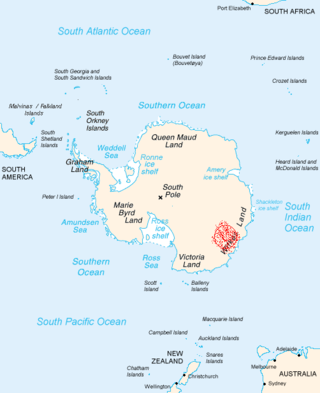Wilkes Land crater
Wilkes Land crater is an informal term that may apply to two separate cases of conjectured giant impact craters hidden beneath the ice cap of Wilkes Land, East Antarctica. These are separated below under the heading Wilkes Land anomaly and Wilkes Land mascon (mass concentration), based on terms used in their principal published reference sources.
Wilkes Land anomaly
A giant impact crater beneath the Wilkes Land ice sheet was first proposed by Richard A. Schmidt in 1962 on the basis of the seismic and gravity discovery of the feature made by the U.S. Victoria Land Traverse in 1959–60 (VLT), and the data provided to Schmidt by John G. Weihaupt, geophysicist of the VLT (Geophysical Studies in Victoria Land, Antarctica, Report No. 1, Geophysical and Polar Research Center, University of Wisconsin, 1–123).[1]
Schmidt further considered the possibility that it might be the elusive source of the tektites of the Australasian strewnfield (which is only 790,000 years old).

The hypothesis was detailed in a paper by Weihaupt in 1976.[2] Evidence cited included a large negative gravity anomaly coincident with a subglacial topographic depression 243 kilometres (151 mi) across and having a minimum depth of 848 metres (2,782 ft).
The claims were challenged by Charles R. Bentley in 1979.[3] On the basis of a 2010 paper by Weihaupt et al.,[4] Bentley's challenge was proven to be incorrect, and the Earth Impact Database (Rajmon 2011) has now reclassified the Wilkes Land Anomaly from a "possible impact crater" to a "probable impact crater" on the basis of Weihaupt et al.'s paper. Several other potential impact crater sites have now been proposed by other investigators in the Ross Sea,[5][6] West Antarctica, and the Weddell Sea.[citation needed]
Mass concentration

The Wilkes Land mass concentration (or mascon) is centered at 70°S 120°E / 70°S 120°E and was first reported at a conference in May 2006 by a team of researchers led by Ralph von Frese and Laramie Potts of Ohio State University.[7][8]
The team used gravity measurements by
Due to the site's location beneath the Antarctic
Because mass concentrations on Earth are expected to dissipate over time, Frese and his collaborators believe the structure must be less than 500 million years old and also note that it appears to have been disturbed by the rift valley that formed 100 million years ago, during the separation of Australia from the Gondwana supercontinent.[8]
The researchers speculate that the putative impact and associated crater may have contributed to this separation by weakening the
Plate reconstructions for the Permian–Triassic boundary place the putative crater directly
The complete absence of a well-defined impact ejecta layer associated with the Permian–Triassic boundary at its outcrops within Victoria Land and the central Transantarctic Mountains argues against there having been any impact capable of creating a crater the size of the hypothesized Wilkes Land impact crater within Antarctica at the Permian–Triassic boundary.[11][12] Nonetheless, according to Frese, recent studies in 2018 seem to sustain the impact origin of the crater, and the event may be linked to the separation of Eastern Antarctica from southern Australia.[13]
See also
- Bedout
- Chicxulub crater
- Cretaceous–Paleogene extinction event
- List of possible impact structures on Earth
- Permian–Triassic extinction event
- Siberian Traps
- Vredefort impact structure
References
- .
- .
- .
- doi:10.1130/l116.1. Abstract.
- ISSN 0020-6814.
- Bibcode:2006LPI....37.1399G.
- Bibcode:2006AGUSM.T41A..08V.
- ^ a b c d Gorder, Pam Frost (June 1, 2006). "Big Bang in Antarctica – Killer Crater Found Under Ice". Ohio State University Research News. Archived from the original on March 6, 2016.
- ISSN 1880-5981.
- ISSN 1525-2027.
- .
- .
- hdl:10084/131644.
External links
![]() Researchers discover giant asteroid impact crater in Antarctica at Wikinews (2006)
Researchers discover giant asteroid impact crater in Antarctica at Wikinews (2006)
- Images of crater area via Ohio State University (archived from the original on 2017-06-12)
- Giant Crater Found: Tied to Worst Mass Extinction Ever Robert Roy Britt (SPACE.com) 1 June 2006 6:07 p.m. ET
- Does a giant crater lie beneath the Antarctic ice? Bibliotecapleyades.net, 2 June 2006.
- Earth Impact Database


